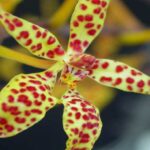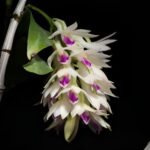Have you ever heard about the genus Doritis? Do you know how to cultivate it?
With few species, this genus became very famous thanks to its hybridization ability with Phalaenopsis.
Thanks to Doritis orchids, several beautiful hybrids were created, known as Doritaenopsis.
In this article, you will learn everything about these little plants.
Learn How to Achieve Super Blooms on Your Orchids
🛑 If you love orchids and you're tired of not being able to make them bloom...
Then, know that thousands of beginner growers are achieving beautiful flowers on their orchids by following this method.
Click the button below to have beautiful orchids with show-worthy flowers every year. ⤵
Important Notice
Formerly, Doritis was a genus of orchids very similar to Phalaenopsis, with its only difference being a small characteristic in the leaves.
But, on April 1st, 2014, everything changed.
With the publication of Genera Orchidacearum Volume 6, this species ceased to exist, and all orchids were transferred to the genus Phalaenopsis.
Therefore, it is important for you to know that:
This article is a “tribute” to this genus, and every time the name Doritis is mentioned for a species, understand that it should be Phalaenopsis.
Curiosities About Doritis Orchids
The name Doritis comes from Greek and means spear, a name given due to the characteristics of this orchid’s lip.
They can be:
- Epiphytes (living on trees)
- Terrestrial (living on organic material)
The vast majority of species in this genus can be considered terrestrial.
As for their size, they are small to medium-sized orchids, averaging from 10 cm to 30 cm.
A curiosity is that the most cultivated orchid in this genus is Doritis pulcherrima, currently known as Phalaenopsis pulcherrima.
Habitat and Hybrids
Regarding their habitat, Doritis orchids are also very similar to Phalaenopsis.
Most of them are ground orchids and can be found in Southeast Asia, especially near rivers and in sandy soils, where they are protected from the sun by trees.
They can be found especially in the following countries:
- Vietnam
- Malaysia
- India
- Thailand
- Sri Lanka
- Nepal
Regarding hybridization, Doritis orchids are widely used to create orchids of great beauty.
Here are some hybrids that use this species.
- Hagerara: Doritis x Phalaenopsis x Vanda
- Doritaenopsis: Doritis x Phalaenopsis
- Aeriditis: Aerides x Doritis
- Doricentrum: Ascocentrum x Doritis
Flowers
This is a genus that usually blooms during the summer.
As for colors, they can vary by species; while some have blue flowers, others may have orange, pink, etc.
Other important characteristics about their flowers are:
- Average size of 5 cm (2 inches)
- Duration of the flowers is 15 to 20 days
- No fragrance
As for their hybrids, they can have various different characteristics in their blooms.
Cultivation
This is considered an orchid of easy cultivation; therefore, it can be recommended for beginners.
Below are the main care tips you should have for orchids in this genus.
- Planting: can be planted in plastic or clay pots, and if your species is epiphytic, it can also be hung in hanging pots.
- Light: ensure an adequate amount of light, but avoid direct sunlight. Refer to the article spots on orchid leaves to learn more about lighting.
- Climate: prefers warmer temperatures. On average, 18°C (64°F) at night and between 29°C to 33°C (84°F to 91°F) during the day (source: AOS).
- Potting mix: some of the most recommended potting mixes are sphagnum, pine bark, and charcoal.
- Watering: water your orchid when the substrate is almost dry; you can do this by checking the substrate with a pencil, as taught in the article how to care for orchids.
- Humidity: an average of 50% humidity is ideal.
- Pests and Diseases: Doritis orchids are mainly attacked by fungal diseases such as Black Rot and Rust. Therefore, if you notice any part of your orchid being ill, cut it and keep it separate from the others.
The above tips also apply to Phalaenopsis pulcherrima.
Conclusion and Study Tips
During my research, I found several places with great information for you to learn more about these orchids.
So, if you want to deepen your study in this genus of orchids, see the link below:
Now it’s your turn.
Did you like this article? Then share it on your social networks and leave a comment below telling us how your cultivation is going.
















